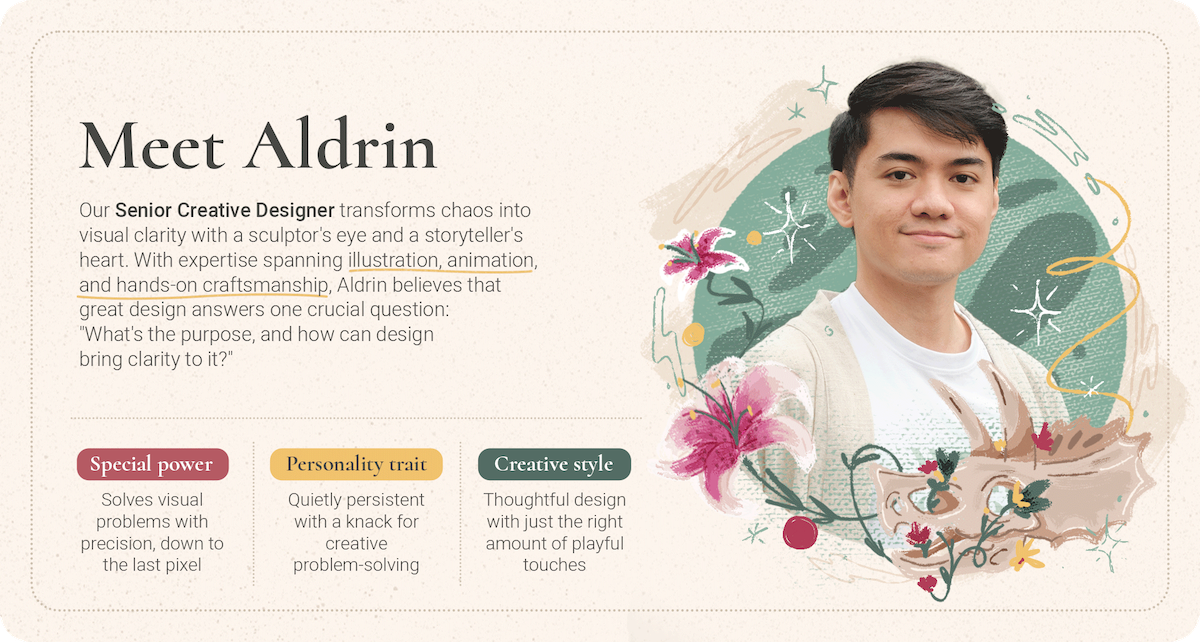Ah, yes, the listicle—a hugely popular and equally divisive blog post format.
If you’ve ever been online before, you’ll have encountered some permutation of this, from “9 healthy foods that will speed up your metabolism” to “12 random facts that will change your mind about Lady Gaga.” It’s typically any type of content written out as a list (and we mean any).
According to the Merriam-Webster Dictionary, the first known use of the term “listicle”—a portmanteau of “list” and article”—was in 2007. But its popularity dates back much further than you think.
One of the first listicles to go viral was a little number titled “The Fate of the Apostles,” a juicy exposé that outlined the demise of Jesus’ followers, such as those who were “run through the body with a lance” versus those who were “stoned and then beheaded.”
 This was in the 1800s where “viral” meant being circulated across print publications. “The Fate of the Apostles” appeared in at least 110 publications, but required over 50 years to get that mileage.
This was in the 1800s where “viral” meant being circulated across print publications. “The Fate of the Apostles” appeared in at least 110 publications, but required over 50 years to get that mileage.
These days, listicles are being churned out faster than butter and spread over social media by the thousands in less than a day. And it’s all thanks to internet new media company Buzzfeed who came into the scene back in 2006.
At the peak of its popularity, there wasn’t anyone who wasn’t reading up on the “36 Perfect Tweets That Made Queer People Cackle Out Loud” or taking quizzes gauging “How Well You Actually Know Harry Potter?”
Brands, companies, and publications all want a share in that kind of readership. The question is, how can you create quality content like listicles that stand out and get views in this day and age?
First, we need to understand why listicles are so effective
Let’s answer that in listicle form:
1. Listicles tell you what to expect
You’ll notice that many have numbers in the title—“X reasons you should bullet journal” or “X quotes that will inspire you to go to bed early.”
That’s intentional. The author wants you to know that this article is a fun and easy listicle about some specific topic of interest to you.
2. Listicles are easy to read and process
Because of the way listicles are structured, they’re far easier to parse than traditional long-form content.
Ideas are categorized neatly into lists, and readers have the option of skimming through these ideas and zeroing in on a relevant point.
3. Listicles are shareable
The easy readability of the listicle makes them more shareable too. Listicles don’t demand too much time, so there’s less reason for someone not to click on one.
4. Listicles meet the needs of today’s digital content landscape
Lastly, the digital age has exacerbated the need for more bite-sized, quality content. As the internet is absolutely saturated with content, there’s more information today than any one person can consume in a lifetime.
Since life is too precious to waste on a bad article, more often than not, we turn to the listicle.
Let’s address the elephant in the room
Amassing this much popularity has inevitably garnered the listicle some haters.
“Serious” readers, journalists, and publications have expressed their ire over the format. They’re shallow. They’re clickbait. They’re giving you ADHD. And more importantly, they’re cannibalizing “long-form, thought-provoking pieces” and making the world a dumber place.
And yet, many of these listicle haters titled their articles as listicles—to be ironic, for sure, but arguably, to get views too.
Most of these were parodies of listicles, starting off with “just kidding” and proceeding like any old long-form piece to make a point. Did these end up being the thought-provoking content that critics assume listicles are replacing? Mmm. No, not really.
As I read through their arguments (skimmed, for some), I didn’t find any points against the humble listicle that could have been said more effectively in long-form than if it had been in list form. Trite content can come in many formats, not just in listicle.
That’s not to say there are no bad listicles—the internet is teeming with them. But just as there is a time and a place for a thought leadership piece, there is a time and a place for a listicle too.
At the end of the day, a listicle is a tool, much like quotes, photographs, or charts, to communicate an idea. And a potentially effective one at that.
So why do listicles work in spite of these objections?
To answer that, we need to go back to Buzzfeed, the company responsible for making listicles a thing.
Not surprisingly, Buzzfeed was originally started as a way to track viral stories around the web, until eventually, the company decided to start creating content of its own. Most notably, in listicle format.
By 2016, Buzzfeed became the 47th most popular website in the United States, and 140th in the world garnering a whopping 7 billion views each month from 200 million unique visitors. And among their most viral articles, 65% of them were listicles.

Many individuals and companies have attempted to dissect the virality of the Buzzfeed listicle and figure out the company’s big secret.
One study by Social Media Today explains that Buzzfeed’s success has a formula, breaking down the company’s top listicles by the average number of characters it uses in its headlines (among other quantitative observations).
Others believe that Buzzfeed’s success is simple “social supply and demand.” The company tracks down content that people are already eating up, and packages it into one comprehensive listicle that’s easy to share on social media.
Still others attribute it to the company’s ability to create lots of content, include pop culture references in every item, and post on social media frequently and consistently.
But one Entrepreneur article was able to look beyond these technicalities and identify the company’s real “secret sauce”—the reason why, until this day, Buzzfeed is still raking in millions of views in spite of the company’s dip in popularity.
It’s not data, references, and word count that make people want to read and share a Buzzfeed article.
It’s the ability of its content to elicit an emotional response.
The power of eliciting emotions
“We think of media as something people use to help them in their lives,” Buzzfeed CEO Jonah Peretti was quoted saying in the article.
Peretti’s first brush with virality came when he emailed Nike with a request to customize a sneaker with the words “sweatshop” embedded on it—a reference to Nike’s not-so-secret labor issues. Of course, the company refused. But a sly Peretti emailed his correspondence with the shoe brand to a number of friends, and before he knew it, his email reached millions of people.
This experience quickly revealed that “evoking an emotion was more important than the journalistic quality of the content itself.”

While on the surface, “27 Cats Who Are A Better Human Than You” seems like just another cat listicle, it also makes people who see the angry grey British Shorthair in heels say “awwww.” And just maybe, less alone in their cat-loving ways.
With articles like “19 Reasons Why Women Are So Much Stronger Than Men Could Ever Dare To Be” and “13 People Shared Their Favourite Memories From Pride, And Honestly They’re So Heartwarming,” Buzzfeed addresses communities who, for one reason or another, are seldom acknowledged or represented in local media.
And that’s precisely why one might read and share their articles.
So how can you apply any of this to your own content marketing efforts?
Simply be relevant—to someone.
The more specific your content, the better.
That might sound like counterintuitive advice considering we were just talking about “virality” and garnering hundreds of millions of views. But a savvy marketer can tell you that virality is not a viable goal for any content marketing campaign, just a happy accident (a blog post for another day perhaps?). The goal is to craft marketing messages that resonate with people.
As Nancy Duarte put it in a Harvard Business Review article, “Good content meets audiences where they are, and it’s tailored to them.”
That means creating content that’s useful or relatable, or really anything that might strike a chord with someone you know. You can apply this to content marketing in a number of ways:
1. How-to listicles
People love content that’s fundamentally useful for their hobbies or field of work. These types of listicles are best suited for new professionals looking to improve on their skills or learn a new technique from another expert.

This example by Piktochart is targeted towards graphic designers or graphic designer stand-ins at companies to help them level-up their infographic games. Not only does this listicle provide specific and actionable advice, but it also does so in a way that’s easy to understand.
If you’re an industry expert in a certain field, how-tos are a great way to showcase your expertise and help out your target audience at the same time.
2. Educational listicles
Listicles are excellent at breaking down complex topics and zeroing in on a specific problem that readers might have. For example, getting a work visa in Singapore has proven to be an increasingly difficult task in recent years, with tightening immigration policies for foreign workers.

This blog post by cloud corporate services company Lanturn helps local businesses in Singapore understand these challenges and provides helpful insights that might help them get around these.
In doing so, Lanturn better informs businesses and promotes its own services at the same time.
3. Advice listicles
Before the pandemic, there were over 445 million business trips happening every year. Without a doubt, an article like “6 things business travellers should know when visiting Japan” strikes a chord with someone out there.

And when it comes to traveling to a foreign country, the question of culture and etiquette arises—what’s the appropriate way to talk and act in a place like this? Something that may be considered polite here may potentially be seen as rude somewhere else.
This comprehensive guide provides business travelers with the advice they need to navigate this new land, in an easy-to-follow listicle format.
4. News listicles
A lot of new outlets are leveraging listicles to provide an overview of the latest headlines. Some collate articles on a certain topic, so viewers who are following the story have a full picture. Meanwhile, others also use it to highlight some of the latest developments in their field.
Tech in Asia, for example, has a regular roundup of “rising startups in Southeast Asia”—startups who may have recently raised funding or announced some new, exciting development.
This type of content is appropriate for their readers, usually investors, who want to stay up to date with new promising startups.
5. Expert roundup
Experts tell us lots of different things. How do you keep up with all the good advice they have to offer? With a quick and easy expert roundup!
You can format this in different ways—you can collate the advice of a number of different experts on a single topic. Or you can get one expert to provide his or her advice on different topics.

This listicle by blockchain-backed data analytics company DataVLT gives us an insight into what they think the top data analytics trends in 2020 will be.
Love ‘em or hate ‘em, you’re probably still reading ‘em
With all that said, we hope you see listicles in a whole new light. The humble listicle has been around for centuries—heck, maybe even millennia! (cough the Ten Commandments cough.) And if it’s good enough to guide us on how to live our lives, it’s certainly earned its place in your content marketing plans.
Good luck and happy listicle-ing!
–
Click on the slides below for our step-by-step guide to crafting your own viral listicle:
—
200+ industry-leading tech companies in Southeast Asia are happy clients of With Content. Join them and start delivering valuable content to your potential customers today.




